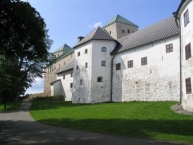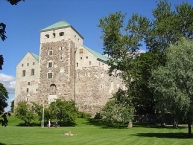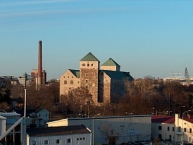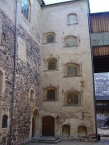Burg Turku
Worth visiting
Added on 15 Apr 2013,
last edited by »Ottocolor« on 16 Apr 2013
Nearby cycle routes and tours
| Route name | Type | Dist. to route |
|---|---|---|
Route | 0,1 km | |
Route | 0,1 km | |
Route | 0,1 km | |
Route | 2,7 km | |
Route | 3,2 km |
![]()
Please wait - map data are loading
Type of sights
Castle/palace
Name and address
Burg Turku
Turku castle/Turun linna
Linnankatu 80
FI-20100 Turku
GEO-data
Geodetic coordinates
60.435679 22.229149
Elevation
8 m
Communication
Phone
+358 ∎ ∎∎∎∎∎∎
Internet
∎∎∎.∎∎∎∎∎∎∎∎∎∎.∎∎/∎∎/∎∎∎∎∎-∎∎∎∎∎∎_∎∎




Turku Castle (Finnish: Turun linna, Swedish: Åbo slott) is a medieval building in the city of Turku in Finland. Together with Turku Cathedral
, the castle is one of the oldest buildings still in use in Finland. Turku Castle is the largest surviving medieval building in Finland. It was founded in the late 13th century and stands on the banks of the Aura River
.
History
A start was made on building the castle in about 1280. The Swedish conquerors of Finland intended it originally as a military fortress . During the next two centuries its defences were strengthened and living quarters were added. The castle served as a bastion
and administrative centre in Eastland, as Finland was then known, during the Swedish period. The main part of the castle was extended considerably during the 16th century after Gustav Vasa
had ascended the Swedish throne and his son John
headed the Finnish administration following his promotion to duke. The bailey
was also supplemented and the round tower at the southeast corner of the bailey was added. Since then no part of the castle has been added or extended, only repaired.
The castle was ruled in different stages of its history by the castle sheriff, commander, regent, duke or governor-general. Its significance as a defensive fortress and administrative centre varied throughout the ages according to the political situation. Only once did the castle actually figure in the defence of the realm. This was when Russian invaders from Novgorod destroyed Turku in 1318. On the other hand, it frequently played a role in internal struggles for power within Sweden-Finland and the Kalmar Union
. Not until the end of 16th century did it really enjoy peace. The castle lost its status as an administrative centre in the 17th century after Per Brahe
's period as governor-general of Finland came to an end.
Construction
The layout of the castle consists of the Medieval keep (päälinna) and Renaissance bailey
(esilinna). The keep consists of a square fort with two square gateway towers whose wall thickness at the base is some 5 meters.
In the Middle Ages the castle was surrounded by a moat conjoining with the River Aura
, the castle effectively lying on an island. The keep was completed in the early 15th century. Construction of the bailey was begun in the late 15th century and finished in the 16th. The bailey is not as heavily fortified as the keep, but it has several turrets
. The Renaissance construction work included heavy modification of nearly all the rooms in the older medieval part of the castle. Since the Renaissance no additions have been made to the castle.
The modest military fortification grew into a massive greystone castle, whose solid walls have witnessed many milestones in Nordic history. The castle has been subject to numerous sieges
and several battles have been waged aside its walls. Of all Finnish castles, Turku castle has the most warlike history besides Vyborg castle
and Olavinlinna
.
Information about copyright | |
|---|---|
Rights characteristic / license | by-sa: CREATIVE COMMONS Attribution-ShareAlike |
Link to the description of the license | |
Input taken over from: |
Turku Castle. (2013, March 25). In Wikipedia, The Free Encyclopedia. Retrieved 17:41, April 15, 2013, from http://en.wikipedia.org/w/index.php?title=Turku_Castle&oldid=546966293 |
taken over / edited on | 15 Apr 2013
|
taken over / edited by |
|
Hours of opening:
- Tue–Sun 10–18
- Mondays closed
Limited opening times 2013
- Thur 28 March 10–15
- Tue 30 April 10–15
- Thur 20 June 10–15
- Thur 5 December 10–15
The museum is closed
- 29 March – 1 April
- 1 May
- 9 May
- 21–23 June
- 6 December
- 24–25 December
- 31 December – 1 January
Nearby cycle routes and tours
| Route name | Type | Dist. to route |
|---|---|---|
Route | 0,1 km | |
Route | 0,1 km | |
Route | 0,1 km | |
Route | 2,7 km | |
Route | 3,2 km |
Added on 15 Apr 2013,
last edited by »Ottocolor« on 16 Apr 2013
